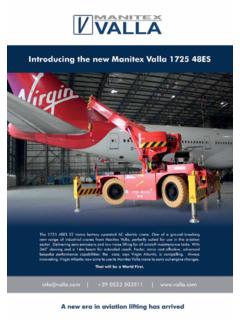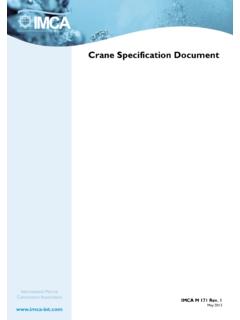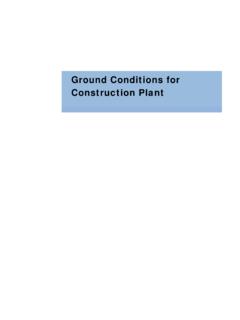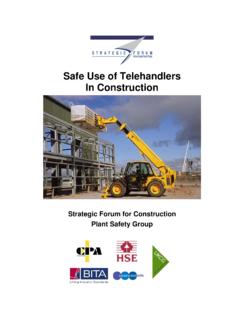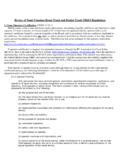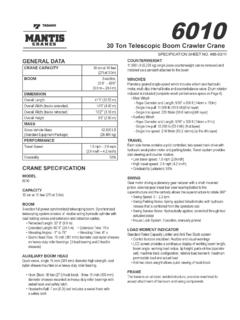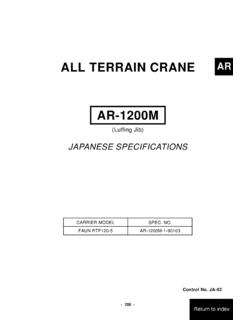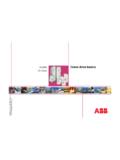Transcription of Crane specification document - vertikal.net
1 AB. Crane specification document International Marine Contractors Association IMCA M 171 Rev. 1. May 2013. AB. The International Marine Contractors Association (IMCA) is the international trade association representing offshore, marine and underwater engineering companies. IMCA promotes improvements in quality, health, safety, environmental and technical standards through the publication of information notes, codes of practice and by other appropriate means. Members are self-regulating through the adoption of IMCA. guidelines as appropriate. They commit to act as responsible members by following relevant guidelines and being willing to be audited against compliance with them by their clients. There are two core activities that relate to all members: Competence & Training Safety, Environment & Legislation The Association is organised through four distinct divisions, each covering a specific area of members' interests: Diving, Marine, Offshore Survey, Remote Systems & ROV.
2 There are also five regional sections which facilitate work on issues affecting members in their local geographic area . Asia-Pacific, Central & North America, Europe & Africa, Middle East & India and South America. IMCA M 171 Rev. 1. This document supersedes IMCA M 171 (issued in July 2003). which has now been withdrawn. This document includes new sections on man-riding and personnel lifting; and certification and documentation of multi- layer winches. The information contained herein is given for guidance only and endeavours to reflect best industry practice. For the avoidance of doubt no legal liability shall attach to any guidance and/or recommendation and/or statement herein contained. 2013 IMCA International Marine Contractors Association Crane specification document IMCA M 171 Rev. 1 May 2013. 1 Introduction .. 1. Summary ..1. Layout of This document ..1. 2 Functional and Technical specification .. 2. Crane 's Functional Purpose.
3 2. Crane Arrangement ..2. Vessel Motions ..2. Crane Type ..3. Boom Lifting Capacity and Working Radius .. 4. Working Height ..5. Lift Hook, Luff and Slew Speed ..5. Off Lead/Side Lead ..6. Environmental Operating Conditions .. 6. Constant Tension/Heave Compensation .. 6. Wire Construction ..7. 3 Supply Requirements .. 8. Choice of Drive System ..8. Supply Voltage ..8. Starting and Operating Current .. 8. Power Requirements ..9. Hydraulic System 9. Cable Requirements .. 10. Man-riding and Personnel Lifting .. 10. 4 Control/Instrumentation System Requirements .. 11. Operator's Cabin .. 11. Cabin Controls and Instruments .. 11. Remote Control .. 11. Safety and Emergency Devices .. 11. 5 Maintenance and Repair Requirements .. 13. Recommended Spares .. 13. Maintenance Programme .. 13. Maintenance Access and Aids .. 13. 6 Testing, Installation, Trials and Training .. 15. Testing .. 15. Failure Modes and Effects Analysis (FMEA).
4 15. Installation and Commissioning .. 15. Trials .. 16. Training .. 16. 7 Certification and Documentation .. 17. Certification .. 17. Documentation .. 17. Multi-layer 18. Appendices 1 Crane Bid Information Questionnaire .. 19. Instructions for Completion of the Crane Bid Information Questionnaire .. 19. 2 Crane Vessel Selection Criteria .. 28. 1 Introduction This document was originally published in July 2003. It has recently been reviewed and now contains updated sections on man-riding and personnel lifting (section ) and the certification and documentation of multi-layer winches (section ). Summary The document discusses the various aspects of Crane design and performance in general terms only and intends to make the customer aware of the various options available for consideration. The intention is that the customer will approach the Crane provider with a functional specification that contains the minimum of technical requirements.
5 The Crane provider can then respond describing how it intends to meet the functional requirements. This response will contain a detailed technical specification . The final design of the Crane can then be agreed at further clarification meetings. Offshore Crane design is unique in that almost every new build Crane will be a one-off in some respect in order to meet the customer's specific requirements. It is recognised that many customers have extensive experience of Crane purchase and it would be expected that the customer and manufacturer would interact early in the design stage to ensure that the best Crane for the job is designed, purchased and installed. It is hoped that, by involving both customers and providers in the drafting of this document , a useful tool is developed which will ensure that all aspects of the Crane 's design and performance are understood and discussed at the earliest possible stage in the process.
6 It is intended that this document can equally be used by customers either purchasing a new Crane for installation on their vessel or chartering a vessel in order to carry out a lifting operation using that vessel's Crane . Where the term manufacturer' or provider' is used, it should be understood that these terms are interchangeable depending upon whether the purchase or charter of a Crane is being discussed. This document can also be used for the specification of other lifting appliances used for lifting in an offshore environment. Layout of This document This document is in three parts. The first part contains the explanatory notes designed to aid the user in application of the questionnaire which forms the second part (Appendix 1). The questionnaire forming the second part is in the format of a table intended for use in an enquiry or request for quotation or contract to provide a Crane . It is clearly referenced to the relevant parts of the explanatory notes.
7 The third part consists of a brief checklist (Appendix 2) which can be used as an information exchange when chartering a Crane vessel. The Crane specification is naturally quite detailed, as it is meant to assist in the provision of cranes required for a range of purposes. It is intended to be tailored to suit individual companies' needs as required in the various stages of developing the Crane specification . IMCA M 171 Rev. 1 1. 2 Functional and Technical specification Crane 's Functional Purpose The customer should give as much information as possible regarding the Crane 's intended purpose. This may seem obvious but good information at this stage will greatly assist the provider in supplying the best Crane for the job. Using a Crane for tasks outside its design intent significantly increases safety risks, Crane failures and downtime. Most of the detail of the Crane 's intended use is contained in subsequent sections but at this stage the customer should detail: a) General description of the type and size of the vessel (including flag and classification society) and the intended use of the Crane , internal lifts, subsea construction, retrieval of loads from subsea, remotely operated vehicle (ROV) support, supply vessel operations, vessel to vessel lifts, vessel to platform lifts and personnel lifting, is it to be a marine Crane or an offshore Crane ?
8 B) Where will the Crane be used in port, at sea, subsea or surface only? c) Will the Crane be required to perform personnel transfer operations? d) An indication of the design loads, life and estimated average running time. e) A visit to the vessel by a representative of the Crane provider may be beneficial if it can be arranged. Crane Arrangement Where does the customer intend to place the Crane ? Forward, aft or amidships? Does it need to be on the centreline to serve both sides of the vessel or towards one side to favour the vessel's usual operations? Vessel motions are greater towards the bow and stern of the vessel and therefore, in this respect, the ideal location for a Crane which is to be used for offshore work will be nearer the midship section of the hull. A Crane placed towards the port or starboard sides of the vessel will be able to take advantage of the greater strength which generally exists in the hull at these points.
9 Does it need to reach the quayside or the sea surface on both sides of the vessel? Is it desirable to place the Crane outside of the hull, on a box section? Is the Crane to be located adjacent to a helideck? What space is available for mounting the Crane ? If space is extremely tight then certain types of Crane with a smaller footprint may need to be considered. What degree of rotation is required? In most cases this will be 360 but occasionally this may be reduced if the Crane is to be located flush against an accommodation block for example ( bulkhead'. cranes). There may be cost savings to be made by utilising cable chains instead of slip rings or hydraulic joints in cranes which are restricted to less than full rotational freedom. Mast cranes which have the winches mounted in or near the base of the Crane can achieve approximately 400 of rotation ( one full rotation plus 40 before having to reverse direction). The operator has to be aware of where the 0 point lies, as this cannot be crossed.
10 For handling of items on deck this can be limiting. If the Crane is required to operate in hazardous areas then it will need to be built to, or be suitable for, the applicable electrical standards. However, careful consideration of the actual extent of the hazardous area can reduce the amount of upgrading of the Crane required and still achieve hook coverage into the hazardous area. This can be achieved by only having the boom or part of the boom rated for hazardous areas or by raising the Crane machinery room, cab and jib above the hazardous area. Consideration should be given to the location of the boom and hook rest. On larger cranes this may be a substantial structure in itself and will take up a sizable deck area. The customer may require the Crane provider to design and supply the boom rest but typically the Crane provider will supply information concerning the dimensions and weights involved and leave the actual design and construction to the customer's subcontractor.
